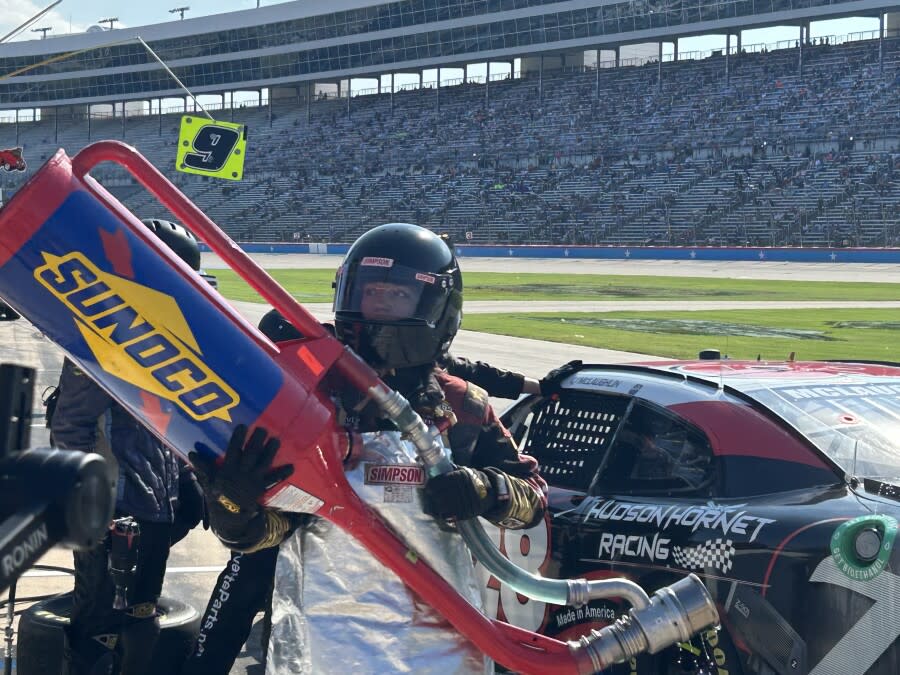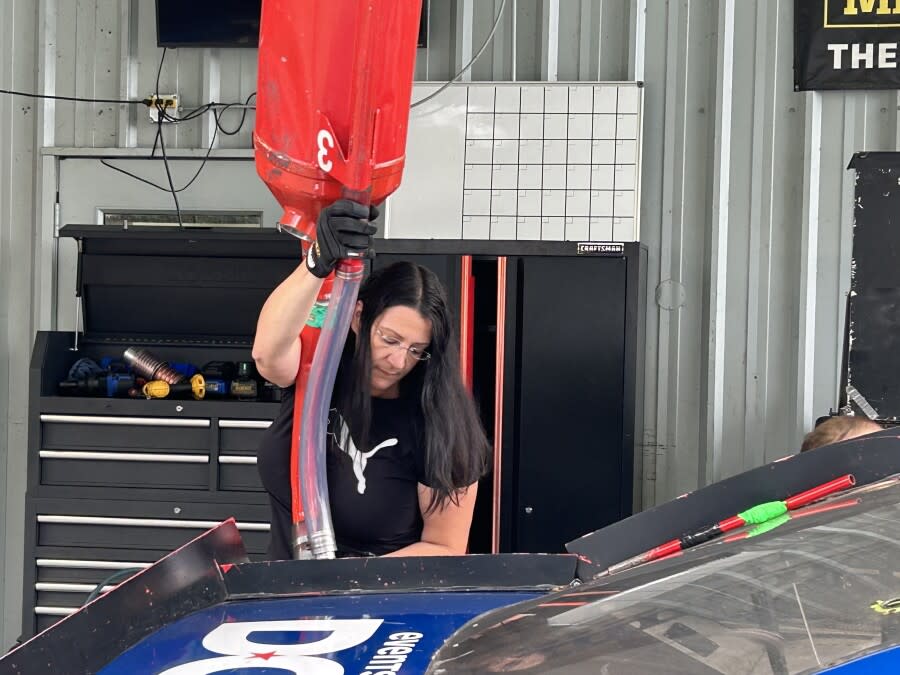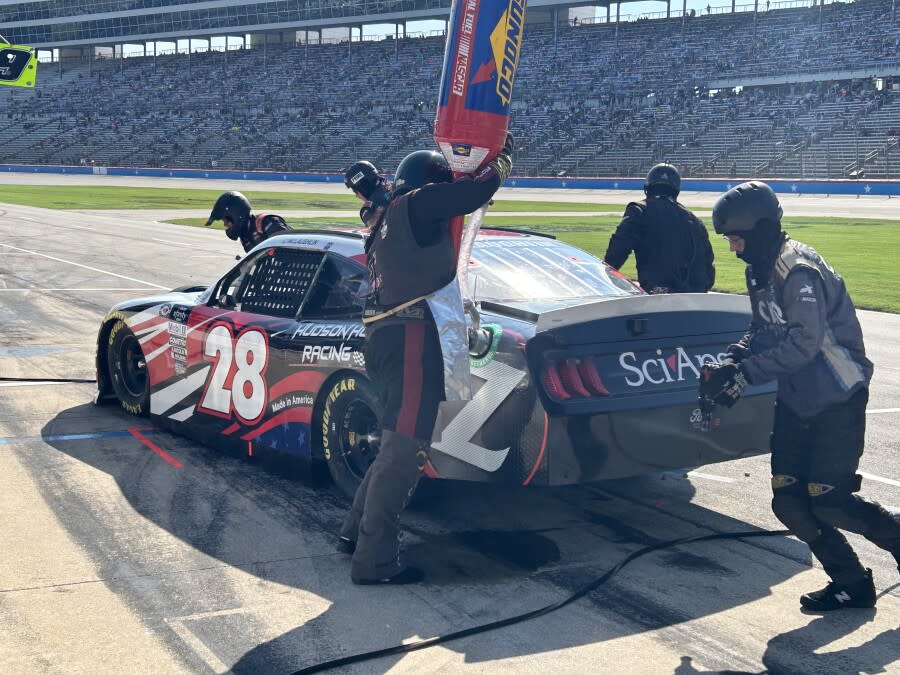Friday 5: Long journey led Infield Jen to become only female fueler in NASCAR Xfinity Series
CONCORD, N.C. — When Jen Calandrillo decided two years ago that she wanted to be a fueler on a NASCAR pit crew, she sought the advice of a pit coach.
He quickly asked her how old she was. She said 45.
“You can’t do it. … You’re too old.”
He then asked how much she weighed.
“Wow,” Calandrillo thought, “You are really asking the wrong questions.”
Calandrillo, who stands 6 foot, told him she weighed 160 pounds.
“You can’t do it because you don’t weigh enough.”
“Nobody’s ever told me that before,” she said.
The coach’s point was that a NASCAR fueler should weigh twice as much as a full fuel can. At capacity, a fuel can weighs about 100 pounds.
Based on the coach’s belief, Calandrillo needed to gain 40 pounds.
So she did.
Calandrillo, now 47, will be among the oldest crew members to go over the pit wall and the only female fueler in Saturday’s Xfinity Series race at Las Vegas Motor Speedway (3:30 p.m. ET on USA Network). She’ll be on the pit crew for the No. 28 car of C.J. McLaughlin for RSS Racing with Jeff Lefcourt.
Calandrillo, a Brooklyn native whose accent has not softened after more than a decade in North Carolina, has gone from someone who knew little about NASCAR to doing something no other female does.
Plan comes together
A co-worker’s suggestion on its own might not have been enough to sway Calandrillo to become a pioneer, but it was one of a series of events that pushed her to set the lofty goal.
It started when her doctor said she needed to go to the gym.
“I go to the track every week and I walk around like crazy,” Calandrillo told her doctor. “I’m in decent shape.”
The doctor said going to the gym would be more beneficial.
The next day, while at StarCom Racing in 2021, she and a co-worker were changing the heads on the fuel cans when he told her: “You’ve done everything with these, why don’t you just go over the wall with these cans?”
That would give her a goal to strive for at the gym, but what type of training would she need?
The day after that conversation in the shop, a friend, who is a financial advisor, called and asked her to help a client with their website. Among Calandrillo’s skills is website design. The client who needed help? He was a trainer.
She had the motivation to go to the gym and someone who could help her achieve her goals.
Now the work began.
Looking for a job in NASCAR
That Calandrillo found herself in NASCAR was something she once wouldn’t have expected. She knew about the sport but didn’t follow it closely until she dated a guy years ago who was a fan. He liked Dale Earnhardt Sr., so she rooted for Jeff Gordon and then Dale Earnhardt Jr.
Her interest in the sport grew. In 2004, International Speedway Corp., agreed to purchase 676 acres on Staten Island for a racetrack. Calandrillo was excited about a potential NASCAR race near New York City.
She was a part of a grassroots campaign by New York NASCAR fans to encourage support for the Staten Island project. As part of that effort, NASCAR brought members of that campaign, including Calandrillo, to the track.
Although ISC’s effort failed and the land was sold in 2013, Calandrillo remained committed to the sport.
“I decided, ‘Well, if it’s not coming here, I’m going to it,’” she told NBC Sports.
She left her job as a bank branch manager in 2010 to move to North Carolina and search of a job in the sport.
When Calandrillo went to the track, she would take a picture with drivers, team owners and crew members after talking with them. When she saw them again, she had them sign the picture and gave them her resume.
“If you want to be in the sport, you’ve got to be a familiar face,” she said.

She also posted pictures from the track on Infield Parking, a social network site for NASCAR fans co-founded by Dale Earnhardt Jr. One person took her pictures and made a Facebook page for her. She was unaware of that. All she knew was that she started receiving numerous friend requests. Calandrillo didn’t know those people, so she deleted the requests.
The person who put together the Facebook page later reached out to her and asked Calandrillo what she thought of it. She checked out the page and saw that more than 150 people had liked it in a short time. Calandrillo started talking to fans through the site.
Later in 2010, she went to a race in Atlanta and was asked by a NASCAR fan on Facebook to take a picture of Kurt Busch by his car. She did and posted it.
She soon received more such requests. Calandrillo posted those pictures and answered questions fans had. That led to her Infield Jen moniker.
While her online presence grew, she continued to search for a job in the sport. A couple of weeks before the 2011 season began, Brian Keselowski asked if she was available. He needed a PR person. She was told to come to the shop the following Tuesday.
When she showed up, she was told she had the job. Calandrillo pinched Keselowski to make sure this was real. Then she asked if he was truly going to Daytona International Speedway. She had never been there and that was the one track she most wanted to visit.
“Technically, my first day on the job was the day Brian made the Daytona 500,” she said, referring to when Brian, now her fiancé, made the 500 with help from his younger brother Brad in their qualifying race. “That, honestly, was the best day of my life.”
Learning multiple skills
Working with a small team, Calandrillo learned many mechanical skills from Brian Keselowski and his dad, Bob, who passed away in 2021.
Those abilities allowed her to help in various ways. While working for Brian in the ARCA Menard Series, she went over the wall with the catch can from 2012-15. That position required a person to plug a small can into the car to catch the overflow fuel.
She later worked with various small teams in NASCAR. Calandrillo often took empty fuel cans to the pumps to be filled and brought them back to the pit stall before the next stop. If needed, she would be behind pit wall and grab a tire as it was rolled to her during a stop. Later, she would hand the full fuel cans to the fueler for pit stops.
It was all preparing her, in a way, for the role of a fueler, but she still had to get stronger.
Wayne Coolidge, a health promotion scholar-practitioner who provides wellness consultation and fitness training, put together a plan for her.
Coolidge could tell that she could handle the challenge ahead.
“The biggest and best predictor is a strong ‘why,’” he told NBC Sports. “The true ‘why’ is a deep reason for you to want to accomplish something. … She had that from the beginning.”
She admits she got hooked on going to the gym and doing all she could to be a fueler.
“I really think she wants to be an innovator in a sport that’s been full of innovation since the 50s,” Coolidge said.

She first fueled a vehicle in an April 2022 NASCAR Truck race at Bristol. That race had non-competitive stops where teams had a few minutes to change tires, fuel the vehicle and make any adjustments without losing their position on the track.
She next went over the wall to fuel a car in an ARCA race in May 2022.
“I learned what could go wrong,” she said of that experience.
Typically, she had the fuel cans filled to what was needed for the car but not to capacity. That reduced the can’s weight by about 10 pounds. At the Charlotte ARCA race, her can was filled to capacity and weighed about 100 pounds.
When she moved toward the car, the fuel sloshed in the can, shifting the can’s weight. Then the tire changer stood up, catching her off-guard and causing her to stop, further sloshing the fuel in the can. The momentum forced her to put the can down to avoid dropping it. A couple of crew members helped reposition the can and she fueled the car. The team didn’t lose any time because this also was a non-competitive stop but it made Calandrillo wonder what might have been if this had been a live stop.
“Of all the scenarios I had in my head of what could go wrong, that wasn’t one of them,” she said.
She had more work to do.
“I still needed to get stronger,” Calandrillo said. “Back then, I was fighting the weight of the can. I was still not strong (enough) to carry the can comfortably and go with it.
She wouldn’t fuel a car again until the Martinsville Xfinity race last November. That would be her first live pit stop.
“It’s pretty intense,” she said of that experience. “It’s pretty nerve-racking.”
Work continues
She spent last offseason working out four days a week, each session lasting at least 90 minutes. At this point in the season, she’s in the gym three days a week.
“I have to make her not train,” Coolidge told NBC Sports.
She deadlifts 110-pounds, does 275-pound shoulder shrugs and leg presses 300 pounds. She does multiple sets on each.
“Her energy needs to go to explosive power movement,” Coolidge said of the training regimen.
She practices multiple times a week with Jeremy Turner, who is a pit coach and jackman in the Xfinity Series.
Fueling a car is not as easy as it looks. Along with a 100-pound can of fuel over one shoulder, the fueler has to move efficiently to the car. If the car stops further from the wall, that’s an extra step or two, while maintaining the balance of the can. Also, the nozzle goes into the car at an angle. The fueler often tries to connect to the car as the vehicle is either raised or lowered based on the jackman and which side the tire changers are working.
“You’ve got to be able to maneuver up and down as (well) as back and forth,” Turner told NBC Sports. “It’s a lot more to it than you think, especially if you’ve got 100 pounds on your shoulder.
“Then you also got to think that as the (can) drains, you’re losing that weight, and then you are going back to the wall to get another full can.”
All in a matter of seconds.
It’s taken Calandrillo two years to get to this point. Her work continues. She aspires to fuel a Cup car in a race one day.
“I don’t know if it’s going to happen,” she said, “but I would like to just keep training and trying to get there.”

2. A new point of view
Only one other time has Chris Buescher made the playoffs, so in past years, he was among the nearly 30 drivers on track with the playoff drivers in the Round of 8.
One question that often comes up in the playoffs is how hard should non-playoff drivers race playoff drivers.
As one of eight remaining playoff drivers this season, how does Buescher’s previous experience of being a non-playoff driver shape his expectations with what he has at stake?
“To me, the answer was we don’t pull the other 30 race cars off track when we get down to the Round of 8,” he said ahead of Sunday's playoff race at Las Vegas. “We’re all still on track, so I don’t think there’s any scenario where you should expect cars that aren’t in the playoffs to lay over for you. I just don’t think that’s realistic.
“We weren’t about to do that the last several years, and I don’t feel like anybody did that at the Roval (last weekend) for us because we had a yellow spoiler on the car, and you don’t expect it.
Assessing driver momentum entering Cup Round of 8
Dave Burns, Kyle Petty and Nate Ryan highlight William Byron, Denny Hamlin and Ryan Blaney having momentum entering the Cup Series Round of 8, as well as Tyler Reddick and Chris Buescher lurking below the cutline.
“We’re all still racing the same group of cars every week. We’ll all race the same group of cars in Phoenix. Now, there’s a level of respect that can go with that. … Really it’s not any different than it should be any week, but it should be taken with a little bit more awareness of who you’re racing around and be realistic to it.
“We’ve tried to do that and tried to be smart. It’s worked out well for us. I feel like my reputation in our group is pretty well understood that we’re not going to be that car that’s going to be interfering an excessive amount when the playoffs are on the line and certainly hope that can come around and help us in this scenario.”
A champion will be crowned in less than a month. Buescher has never been this close to a Cup title, but he’s not letting it alter his focus.
“I have not thought about Phoenix whatsoever at this point,” he said. “I’ve thought about Vegas and I’ve given a little bit of thought to Homestead, but it’s very much what’s immediately out front of us, how do we make this weekend the best to set us up for the next one because whatever happens this weekend can dictate what needs to happen next.”
3. Extra advantage
Three times in the last six years, the driver who won the opening race in the Round of 8 went on to win the championship race.
It has happened each of the past two years. Kyle Larson won at Texas to open the Round of 8 in 2021 and went on to claim the title at Phoenix.
Joey Logano won at Las Vegas to begin the Round of 8 and went on to win at Phoenix o score his second Cup title.
Could Sunday's Round of 8 opener at Las Vegas (2 p.m. ET on NBC) make it three years in a row?
“It’s definitely the pivotal race because as we’ve seen – if you can win that race and advance, you give yourself a good chance to prepare for Phoenix,” William Byron said.
“So with winning Texas (opening race in the Round of 12), we’ve given ourselves a couple of weeks to prepare for Las Vegas. I feel like all of that stuff has checked out pretty good. I think our setup is strong there.”
His car was pretty strong at Las Vegas in the spring, winning both stages and the race. Byron led a 1-2-3 Hendrick sweep that day. Kyle Larson was second. Alex Bowman was third.
4. Nowhere to go but up
Ryan Blaney opens the Round of 8 last among the playoff drivers. That’s due to the limited number of playoff points he scored this year. His Talladega win in the last round helped, giving him five more playoff points.
Blaney is 27 points behind series leader William Byron — that’s the closest margin from first to eighth at the beginning of the Round of 8 since stage racing was implemented in 2017.
Still, Blaney knows he faces a challenge.
“It definitely makes it hard for us when we get to the (Round of 8) by not having a ton of playoff points like the 24 group or the 19 or the 5 have,” Blaney said referring to William Byron, Martin Truex Jr. and Kyle Larson. “Yeah, that definitely makes it tough, and it shows you that running well throughout the regular season pays dividends.
“We weren’t able to get very good points throughout those races through the year, but, still, at the end of the day you try to run as good as you can, try to win a race in that round and all that stuff kind of goes away.
“So it just puts you in a little bit worse spot than a couple guys, but you understand that even going into the playoffs, where your playoff points stand and how you stack up around the other cars that you’re racing and adjust accordingly. We don’t really dwell on that stuff too much because that stuff is what it is.”
5. Number crunching
The winner of stage 2 has gone on to win the race at Las Vegas eight of the last 12 times.
Fourteen of the last 17 Las Vegas winners are Cup champions.
Four of the eight remaining playoff drivers have won at least once on each of the three tracks in this round: Denny Hamlin, William Byron, Kyle Larson and Martin Truex Jr.
Chase Elliott’s average finish in the playoffs is 8.0, second only to teammate William Byron’s 5.5 average in the playoffs.
The average age of the Round of 8 playoff drivers is 31.9. That is the second-lowest average age for Round of 8 playoff drivers since 2014. Last year, the average age of Round of 8 drivers was 30.1.

